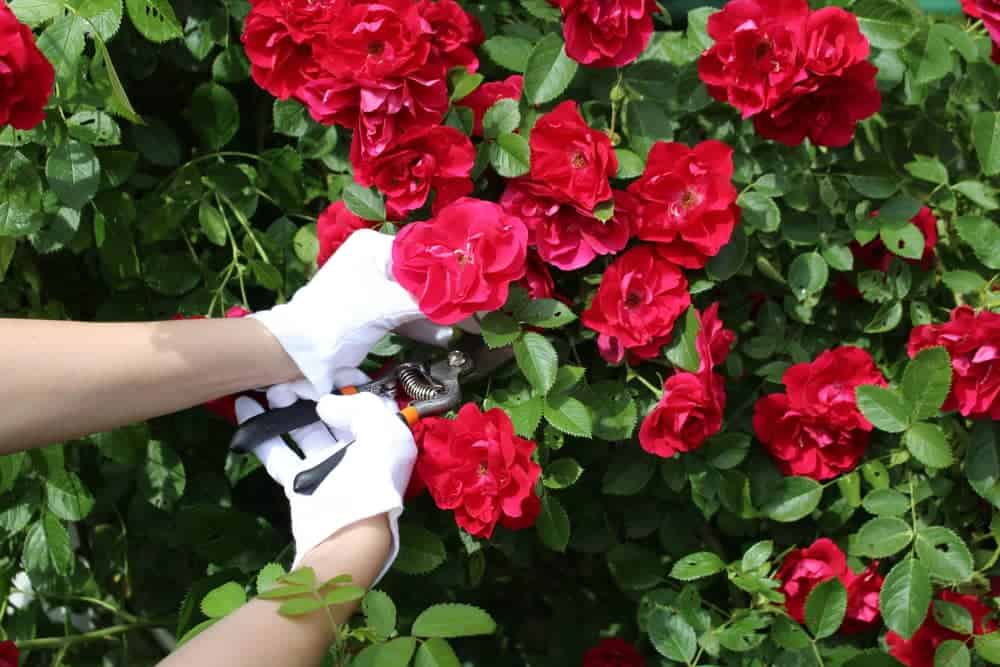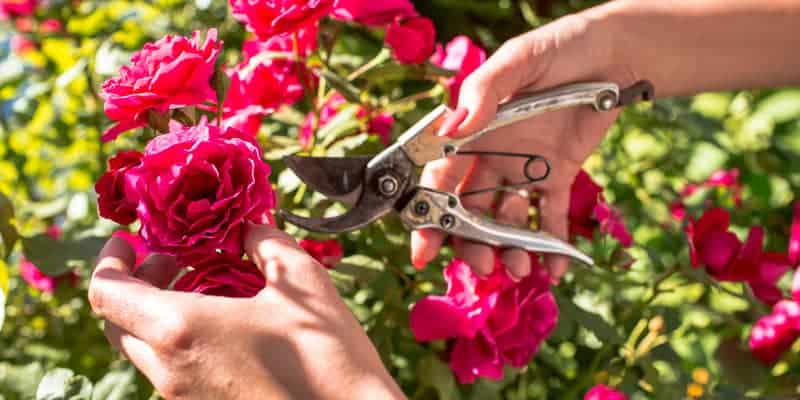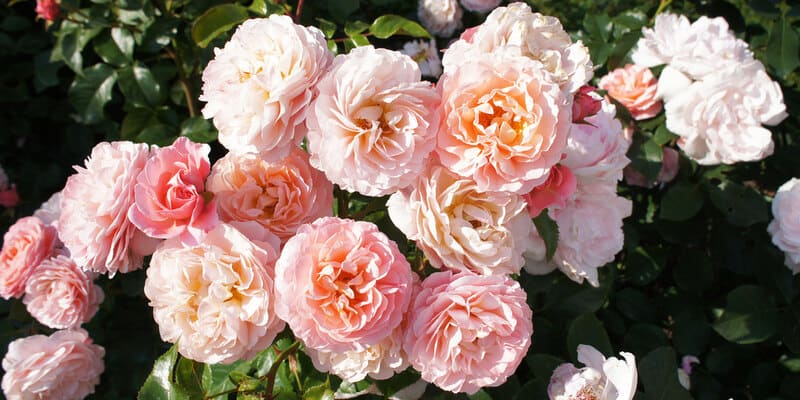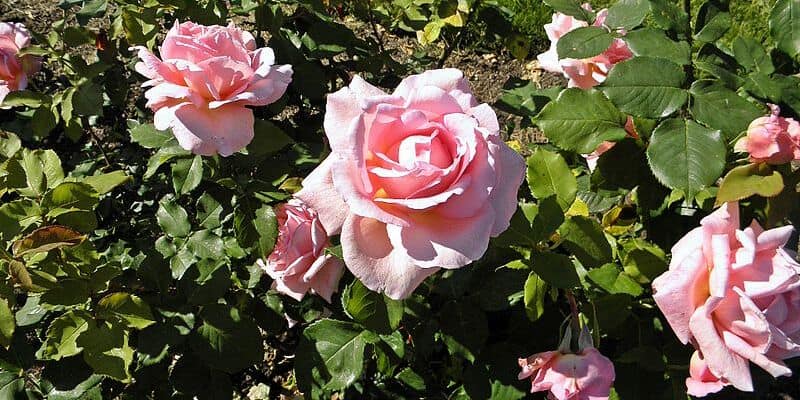For many gardeners, nothing can compare to the beauty of a bush rose in full bloom. And if you want to keep your roses looking their best, they’ll need a bit of pruning now and then!
The Benefits of Pruning Roses
1. Pruning Roses Promotes New Growth
Pruning encourages the production of fresh growth and blooms.
Removing old and dead wood promotes the development of new shoots and buds, which will result in more flowers.
2. Regular Rose Pruning Maintains Shape and Size
Pruning allows you to control the shape and size of your rose bushes.
By removing unwanted or unruly growth, you can maintain a tidy and well-formed bush.
3. Pruning Roses Improves Air Circulation
Pruning helps to improve the circulation of air and light within the bush.
This can help to prevent the growth of mould and mildew and can also help to prevent the spread of pests and diseases.
4. Pruning Increases the Overall Health of the Plant
Pruning helps to remove damaged or diseased wood, which can help you grow healthy rose bushes.
This can also increase the plant’s resistance to pests and diseases.
5. Pruning Extends the Life of Most Roses
Properly pruned plants live longer, as they are better able to withstand pests and diseases and are better able to produce new growth.
When to Prune Roses in Australia
The best time to prune roses in Australia is in late winter or early spring before new growth begins.
This is because the plants are dormant during this time and will not be damaged by pruning. Pruning rose plants in late winter or early spring will also encourage fresh growth and blooms.
However, it’s important to know that roses may not go dormant in tropical regions of Australia, therefore the best time to prune in those regions will be after the blooming season.
Rose Pruning Tools
The most important tool you will need is a pair of sharp pruning shears. Disinfect them beforehand with rubbing alcohol or a solution of bleach and water (1 part bleach per 9 parts water).
It’s also a good idea to wear garden gloves while pruning, as this will help protect your hands from thorns and any other debris on the plant.
A small saw or lopper, or even secateurs, can be used for larger branches.
In the tropical regions of Australia, rose varieties may have thicker canes, so a pruning saw or a pair of loppers may be necessary for pruning them.
How to Prune Roses
Pruning Roses for the Winter
Pruning roses during the winter in Australia can be a great way to spruce up your garden and prepare for the upcoming growing season.
- Wait until after the first frost has passed so that your rose plants don’t suffer any damage.
- Start by lightly snipping off dead blooms and foliage from each stem.
- Remove any dead or diseased branches from the rose bush. This can be easily identified by its brown or black colour. Cut these branches back to healthy wood.
- Remove all leaves before you prune. To make pruning easier, professional hedge trimmers recommend removing all foliage from the main canes before making pruning cuts.
- Trim any branches that are crossing or rubbing against each other. These branches can cause damage to the plant and should be removed.
- Cut any branches that are growing inward towards the centre of the bush. These branches will not receive enough sunlight and will not produce many blooms.
- Prune any branches that are growing too long or too tall. Use sterilised shears or loppers to cut away unwanted stems and branches at 45-degree angles about 10cm above a healthy bud eye.
- Give your rose plants a slow-release fertiliser and mulch to ensure they’re in excellent condition for spring flushing.
- Clean up the area. After pruning your roses, clean up the area around the bush to remove any debris and fallen leaves.
Pruning Roses in the Summer
It can be tricky to prune roses during the summer, as the heat and humidity can make the plants more susceptible to stress and disease.
However, with a bit of care and attention, you’ll do just fine.
- Prune roses early in the morning or late in the afternoon. To avoid the heat of the day, it’s best to prune your roses early in the morning or late in the afternoon when the temperatures are cooler.
- Use sharp, clean tools. It’s important to use sharp and clean tools when pruning to avoid damaging the plant and prevent the spreading of disease.
- Remove dead or damaged wood. Summer is a good time to remove any dead branches or damaged wood from the bush. This will help to promote healthy new growth.
- Shorten long canes. Long canes can become too heavy and may break under the weight of the blooms. Shorten them to a height of about 45cm to encourage new growth and blooms.
- Deadhead spent flowers. Removing spent flowers will encourage new blooms to grow.
- Water the rose plant before and after pruning. During hot summer days, it’s important to make sure that the rose plant is well-watered before and after pruning. This will help to reduce stress on your roses.
- Avoid heavy pruning. It’s best to avoid heavy rose pruning during the summer as it can stress the plant. Instead, focus on removing old or dead wood and shortening long canes.
- Keep an eye out for pests and diseases. The summer heat can make plants more susceptible to pests and diseases. Regularly inspect your rose bushes for signs of infestation or infection, and take measures to control them.
How to Prune Climbing Roses
Pruning climbing roses is an essential part of ensuring they grow healthy and happy, while also helping to keep them looking beautiful.
- Identify the different types of wood. Look for dead, diseased, or damaged wood and remove it. Dead wood is usually brown or black, while healthy wood is green.
- Remove crossing branches. These branches can cause damage to the plant and should be removed.
- Remove inward-growing branches. Branches growing inward towards the centre of the bush will not receive enough sunlight and should be removed.
- Cut back long or tall branches. Cut these branches back to a height of 45cm to encourage new growth and blooms.
- Trim canes that have flowered. Cut back climbing roses just above a bud that points towards the direction you want it to grow. This will encourage the bush to produce more blooms.
- Train the new growth. Once you have pruned the rose plant and removed all the dead branches, train the new flowers to grow in the direction you want them to. This will help shape the plant and ensure it covers the area you want it to.
- Tie the remaining canes. Tying the canes to a trellis or other support structure will help to keep the plant in place and prevent it from breaking under the weight of the blooms.
- Clean up your surroundings. When you’re finished, clean up the area around the rose plant to remove any debris and fallen leaves.
How to Prune Ground Cover Roses
Ground cover roses are quite low-maintenance and do not require frequent pruning, but if you find that portions of your plant have become overgrown, it’s time to whip out your garden shears.
- Use sharp shears or secateurs to carefully remove the thinner and dead branches, aiming to make cuts close to their base.
- Look for any overlapping shoots that may be growing too close together and give them a trim.
- Do a quick assessment of the overall look of your rose bush — if any tufts look too thick, snip away until you achieve the desired shape.
How to Prune Hybrid Tea Roses
One of the best ways to promote gorgeous blooms and vigorous growth in a hybrid tea rose bush is to do dedicated pruning each season.
- Start with an overall evaluation of the plant, determining where and how much should be trimmed. This could involve removing dead canes and crossing branches that may inhibit circulation.
- Look at the individual stems and remove any weak or damaged parts. Trim the roses back to an outward-facing bud and remove extra stems, so there is enough space between each stem.
- After pruning your hybrid teas, give your plants the fertiliser they need and water regularly.
Have Beautiful Blooms in the Flowering Season
Remember, timing is everything when it comes to rose care.
Whether you’re an experienced gardener or just starting out with growing roses, take some time to give your plants some TLC (tender-loving cuts).







